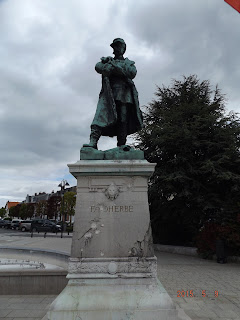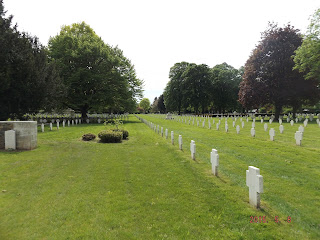Bourlon and Bullecourt.
We were able to spend some time around the community of Bourlon, partly because of my interest in tanks, and partly because we took the opportunity to join in a local 'bread fair' and look around a very local historical display. It was good to see the official memorials, and the scars on the landscape and the community that tell yet more.
It was good to talk with Yves, the chair of the local historical society - such an enthusiast for teaching history and telling and hearing stories of those who are part of that history. How good it was that he was also enthusiastic to practice his english! He is desperate to share in the remembrance of the battles of Bourlon Wood and others in the area with communities from the allied armies fighting.
How good also to spend time with Philippe, another enthusiast, who dug up a tank (http://www.tank-cambrai.com/) and was generous in his time to take us on the journey of finding it, and the history of the crew.
These two men are working hard to keep the history alive, to ensure that a new generation will hear of the sacrifices made, and to challenge thatose new generations to consider their responses to those sacrifices.
The offfical Canadian memorial is a stunning place of great beauty ...
A bullet scarred wall in Bourlon:
Personal remembrance - at the Bourlon fete:
Philippe's personal memorial to all those involved in the battles of Cambrai:
Philippe asks that pictures of Deborah aren't published - but if you would like to see her then get in touch with him ...
Wednesday 7 October 2015
Friday 11 September 2015
Town memorials.
Are interesting in what they suggest of different national character. Travelling through France it was clear that the memorials were more prominent around the old battlefields. Frence memorials also depict 'France' as the object of the soldiers sacrifice, something much less common on British memorials (I can't remember one with 'Brittania' as the main subject). The personal bouquets and memorials on the French town memorials were also striking.
A selection for you ...
Bapaume:
A cotswolds (UK) memorial - with St George slaying a dragon. Always good at the moment to remember St George was a Syrian.Deal in Kent, a town very linked to military service over many centuries:
Travelling around WW1 battlefields, or, frankly, any battlefields, or almost anywhere, there are reminders of the constancy of conflict in human existance. I enjoy the histroy, and the development of strategy and tactics as each new innovation in weapon or armour or fortification comes.
But how sad it is that since classical times we have not learned. A fellow blogger quoted:
A Greek historian, Thucydides, wrote a history of an epic conflict in the mid 5th Century BC. In his introduction he explained his reason for writing his detailed account - so that mankind could read and learn about these barbaric events, and avoid ever going to war again.
His laudable purpose was immeasurably unsuccessful of course, as war is now, and always has been, a murderous constant in human experience.
(http://omg-occasionalmuffledgrunts.blogspot.co.uk/2014/11/how-non-violence-remembrance-is-possible.html)
I enjoyed walking around the Paris Gate at Cambrai - a symbol of previous conflicts. We pointed out the portcullis slots, and murder holes - indeed, we are clever at maiming and killing one another!
But how sad it is that since classical times we have not learned. A fellow blogger quoted:
A Greek historian, Thucydides, wrote a history of an epic conflict in the mid 5th Century BC. In his introduction he explained his reason for writing his detailed account - so that mankind could read and learn about these barbaric events, and avoid ever going to war again.
His laudable purpose was immeasurably unsuccessful of course, as war is now, and always has been, a murderous constant in human experience.
(http://omg-occasionalmuffledgrunts.blogspot.co.uk/2014/11/how-non-violence-remembrance-is-possible.html)
I enjoyed walking around the Paris Gate at Cambrai - a symbol of previous conflicts. We pointed out the portcullis slots, and murder holes - indeed, we are clever at maiming and killing one another!
Friday 26 June 2015
Cambrai German cemetery
A truly international affair - with French, German and commonwealth graves. A couple of notes ...
How far does 'remembrance' and memorial become divisive in themselves. In the week when the US has been discussing the place of the Confederate flag and whether it is or is not a reminder of slavery and race hate, the entrance to this cemetery talks of the gift of the French people to their allies of the land, but not to the Germans, whose graves are also there.
Also the memorial proclaiming how the sword divides but the cross unites, damaged by WW2 fire. How do we as churches reflect on the crosses of different nations filling a field. How can Christians around the world unite to prevent such tragedy. How can we act with Grace towards those who would strive with us for peace. To prevent further fields being filled with crosses, or stars, or crescents.
How very sad that German graves are shared by Jew and Christian, when within a few short years the Jew's family would be oppressed and murdered by the family of the Christian.
How far does 'remembrance' and memorial become divisive in themselves. In the week when the US has been discussing the place of the Confederate flag and whether it is or is not a reminder of slavery and race hate, the entrance to this cemetery talks of the gift of the French people to their allies of the land, but not to the Germans, whose graves are also there.
Also the memorial proclaiming how the sword divides but the cross unites, damaged by WW2 fire. How do we as churches reflect on the crosses of different nations filling a field. How can Christians around the world unite to prevent such tragedy. How can we act with Grace towards those who would strive with us for peace. To prevent further fields being filled with crosses, or stars, or crescents.
How very sad that German graves are shared by Jew and Christian, when within a few short years the Jew's family would be oppressed and murdered by the family of the Christian.
Subscribe to:
Posts (Atom)



















































